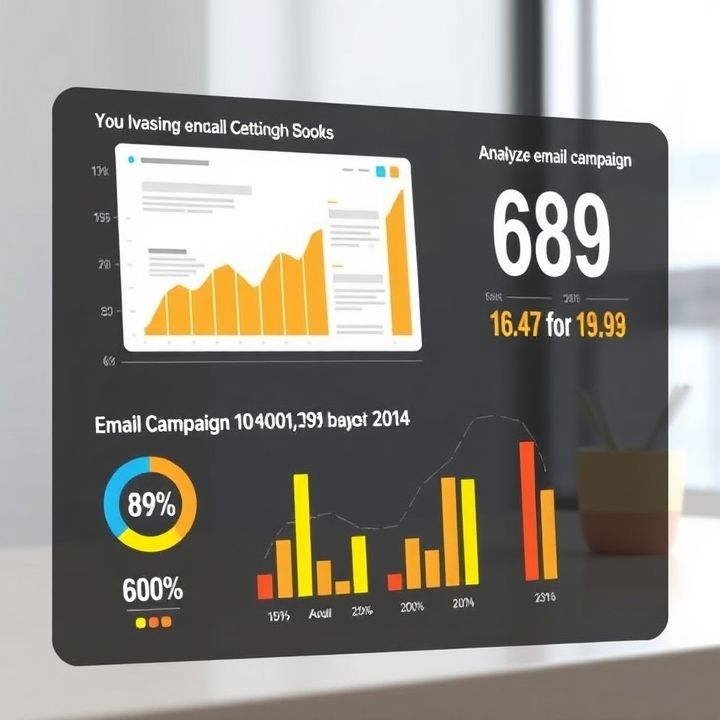Table of Contents
Introduction
Are you ready to uncover the secret sauce that will transform your email sign-up rates from mediocre to spectacular?
Imagine having an ever-growing list of eager subscribers who can’t wait to open your emails and engage with your content. With the right techniques and strategies, this dream can become your reality. Let’s dive into proven methods that will skyrocket your email sign-up conversions and revolutionize your email marketing game!

Here’s a sneak peek at what you’ll discover in this article:
| Technique |
Benefit |
| A/B Testing |
Optimize sign-up forms for maximum conversions |
| Personalization |
Increase engagement with tailored content |
| Lead Magnets |
Attract more subscribers with valuable offers |
Your path to email marketing success starts here. Stay tuned to explore these strategies and more in-depth!
Using Attention-Grabbing Headlines
Using attention-grabbing headlines is a crucial technique for optimizing your email sign-up forms and increasing conversion rates. A powerful headline acts as the first impression and can significantly influence a visitor’s decision to subscribe. To craft an effective headline, consider using specific language that conveys a clear benefit or value proposition. For example, instead of a generic ‘Sign Up for Our Newsletter,’ try something more compelling like ‘Get Exclusive Tips and Updates Directly to Your Inbox.’
Incorporating numbers and statistics can also make your headline more attractive. Phrases like ‘Join 10,000 Happy Subscribers’ or ‘Unlock 5 Expert Strategies’ instill trust and pique curiosity. Another tactic is to create a sense of urgency or scarcity. Headlines such as ‘Limited-Time Offer’ or ‘Join Now to Avoid Missing Out’ can motivate quicker action.
Additionally, keep your headlines concise and to the point. Long or complicated headlines can be off-putting and reduce the likelihood of engagement. Using powerful action verbs and emotionally charged words can further elevate the attractiveness of your headlines, ensuring they grab attention and drive conversions.
Incorporating Social Proof
Incorporating social proof into your email sign-up forms is an effective technique to boost conversion rates. Social proof leverages the influence of others to encourage new sign-ups by building trust and credibility. One way to incorporate social proof is by showcasing testimonials from satisfied subscribers who have found value in your emails. Quotes or short messages from happy customers can be displayed near the sign-up form to provide reassurance.
Another approach is to highlight the number of existing subscribers. A statement such as ‘Join over 10,000 subscribers’ can create a sense of community and belonging, making users more inclined to sign up. Mentioning any awards or recognitions your newsletter has received can further enhance credibility.
You can also include logos of reputable companies or brands that are subscribed to your emails, which serves as a powerful endorsement. Social media follow counts or engagement metrics, such as ‘Followed by thousands on Twitter,’ can also serve as effective social proof elements.
In summary, integrating various forms of social proof into your email sign-up forms can significantly increase trust and drive higher conversion rates by reassuring potential subscribers of the value and credibility of your emails.
Offering Incentives
One effective technique to optimize your email sign-up forms and increase conversion rates is offering incentives. Incentives act as a compelling reason for visitors to provide their email addresses, as they feel they are gaining something valuable in exchange. There are various types of incentives you can offer, such as discounts, free e-books, exclusive content, or entry into a contest or giveaway. For example, an online retailer might offer a 10% discount on the first purchase in exchange for signing up for their newsletter. This not only encourages users to subscribe but also incentivizes immediate purchases.
It’s important to ensure that the incentive is relevant to your target audience and aligns with your brand’s value proposition. Additionally, the incentive should be clearly communicated on the sign-up form through compelling copy and appealing visuals. This can be achieved by highlighting the benefits of subscribing and using a clear call-to-action (CTA) that prompts users to act. By offering the right incentives, you can significantly boost your email sign-up rates and build a more engaged and responsive subscriber list.
Segmenting Your Audience
Segmenting your audience is a crucial technique for optimizing email sign-up forms and increasing conversion rates. By dividing your audience into distinct groups based on various criteria such as demographics, interests, or behavior, you can tailor your messaging to better meet their needs. This personalized approach increases the relevance of your emails, making subscribers more likely to engage with your content.
Start by collecting data through your sign-up forms. Ask for information that will help you understand your audience better, but keep it concise to avoid overwhelming potential subscribers. Use this data to create segments that align with your marketing goals.
For instance, if you run an online retail business, you might segment your audience by purchase history, browsing behavior, or even location. This allows you to send targeted promotions, product recommendations, or local event invitations, thereby boosting engagement and conversion rates.
Once your segments are defined, continually refine them based on subscriber interactions and feedback. Regularly updating your segments ensures that your communications remain relevant and effective. By implementing audience segmentation, you can create more meaningful connections with your subscribers, ultimately driving higher conversion rates.
Using A/B Testing
Using A/B testing is an effective technique to optimize your email sign-up forms and increase conversion rates. A/B testing involves creating two or more versions of your sign-up form and distributing them randomly among visitors to determine which one performs better. This method allows you to test various elements such as headlines, call-to-action buttons, form fields, and images to see which combinations are most appealing and effective to your audience.
By tracking the performance of each variation, you can gather valuable data on user preferences and behaviors. For example, you might find that a shorter form with fewer fields results in higher sign-ups, or that changing the color of your call-to-action button increases click-through rates. These insights enable you to make informed decisions and iterative improvements to your forms.
Moreover, A/B testing helps you understand the nuances of your audience, allowing you to tailor your approach to different segments. This continual process of testing, analyzing, and optimizing ensures that your email sign-up forms are as effective as possible, ultimately leading to higher conversion rates and a more engaged subscriber base.
Simplifying the Form Design
One of the most effective techniques to optimize your email sign-up forms and increase conversion rates is by simplifying the form design. A clean, straightforward design can significantly reduce friction and make the sign-up process more appealing to users.
First, limit the number of fields to only essential information, such as name and email address. Asking for too much information upfront can overwhelm potential subscribers and deter them from completing the form.
Second, use clear and concise language. Your call-to-action (CTA) should be compelling yet straightforward, encouraging users to take the desired action without confusion.
Third, ensure that your form is mobile-friendly. With a growing number of users accessing the internet via mobile devices, it’s crucial that your sign-up forms are responsive and easy to fill out on smaller screens.
Finally, consider the visual aspects of your form. Use whitespace effectively to make the form less intimidating and more inviting. A well-organized layout, with easily readable fonts and contrasting colors, can make a world of difference in user engagement.
Incorporating Strong Call-to-Actions
Incorporating strong call-to-actions (CTAs) is crucial for optimizing your email sign-up forms and increasing conversion rates. A compelling CTA grabs the visitor’s attention and entices them to take action. It’s essential to use clear, concise, and action-oriented language that communicates the value of signing up. Terms like “Subscribe Now,” “Get Started,” or “Join Us” can be more inviting and persuasive. Additionally, positioning your CTA strategically on the page can make a significant difference. Placing it above the fold or at the end of a compelling piece of content ensures that it is easily seen.
Visual elements such as color, size, and design also play a critical role in making your CTA stand out. A contrasting color that aligns with your brand but pops out from the background can draw the eye. Moreover, using directional cues like arrows or highlighting the button can make it more noticeable. Creating a sense of urgency with phrases like “Limited Time Offer” or “Join Today” can further compel users to act immediately. Personalizing your CTA by addressing the reader directly can also enhance its effectiveness. Overall, a well-crafted, strategically placed CTA is an essential component for maximizing email sign-up conversions.
Ensuring Mobile Responsiveness
Ensuring mobile responsiveness is crucial when optimizing your email sign-up forms to increase conversion rates. With a significant portion of users accessing websites via mobile devices, a form that cannot adapt to various screen sizes can deter potential subscribers. Firstly, use a clean and straightforward design that eliminates the need for excessive zooming or scrolling. This can be achieved by employing responsive web design techniques such as flexible grids and layouts.
Secondly, consider the size and spacing of your form fields and buttons. They should be large enough for easy tapping but not so large that they overwhelm the screen. This enhances user experience by allowing effortless navigation through the sign-up process.
Additionally, minimize the number of fields required. Mobile users are often on the go, so a shorter form is more likely to be completed. Fields can also have auto-fill options to speed up the process.
Finally, always test your sign-up forms on various mobile devices to ensure functionality and ease of use. By doing so, you can identify and fix any issues, thereby improving the overall user experience and boosting conversions.
Conclusion
In conclusion, skyrocketing your email sign-up conversions requires a multifaceted approach. By employing attention-grabbing headlines, incorporating social proof, offering valuable incentives, and segmenting your audience, you create a compelling and trustworthy invitation for visitors to subscribe. Simplifying your form design, conducting A/B tests, and ensuring mobile responsiveness further enhance user experience and ease of sign-up. Don’t underestimate the power of a strong and strategically placed call-to-action, as it directs potential subscribers towards completing the process. By meticulously applying these proven techniques, you can build a robust and engaging subscriber list, driving long-term value for your email marketing efforts.
Frequently Asked Questions
What are some key techniques to optimize email sign-up forms?
Key techniques include simplification of the form fields, using clear and compelling CTAs, providing social proof, offering incentives, and ensuring mobile responsiveness.
How does simplifying the form help with conversion rates?
Simplifying the form reduces friction for the user, making it quicker and easier for them to complete the sign-up process, thereby increasing the likelihood of conversion.
What role do clear and compelling CTAs play in optimizing email sign-up forms?
Clear and compelling CTAs guide the user on what action to take next and make the sign-up process more appealing. Effective CTAs use action-oriented language and stand out visually.
Why is offering incentives effective in increasing sign-up conversions?
Offering incentives such as discounts, freebies, or exclusive content can motivate users to sign up because they perceive added value in doing so.
How can you use social proof to enhance sign-up form performance?
Displaying testimonials, reviews, or the number of existing subscribers can build trust and credibility, making new visitors more likely to sign up.

